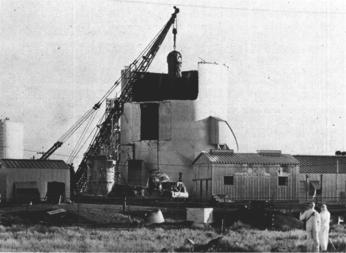high water?
- Thread starter jon hansen
- Start date
Yes the Pacific definitely appears to be a factor in this weekends “event”In case you are wondering what is happening...
The El Niño that lasted for only 2-3 months in 2019 is happening to North America now.
They call it "El Niño" based on a single point threshold that lasts for several months.
So the Heat content was smaller, but it still produces moisture.
The Stratosphere is the coldest in the last 40 year.
Climate Prediction Center - Global Temperature Time Series
This causes the Jet Stream to meander, thus in and out of rain or snow.
Result is a mild wet winter from Pacific Heat.
El Niñito is with us.
Jim...
Its definitely odd that you can go from record low water to record high in just 5 years after all these years..
I believe this polar vortex affected our weather last year (inland Western US) and apparently its raging again this year. From this link (article from Jan 5, 2020) https://www.severe-weather.eu/global-weather/stratospheric-polar-vortex-coldest-fa/
I believe this polar vortex affected our weather last year (inland Western US) and apparently its raging again this year. From this link (article from Jan 5, 2020) https://www.severe-weather.eu/global-weather/stratospheric-polar-vortex-coldest-fa/
The stratospheric polar vortex rages, as it reaches its coldest temperature in the past 40 years. It is set to connect down and dominate the weather patterns as it spins at over 600km/h on top!
Temperature is one indicator of the strength of the polar vortex, as it is usually as cold as it is strong. A better estimate of strength is perhaps the actual power, or wind speed of the polar vortex, or the stratospheric polar jet. The stronger the polar jet, the more likely it is for the polar vortex to connect down with our weather and influence the weather patterns
Combined with the unusually high pressure in the Pacific, this is a perfect recipe for cold air outbreaks into Canada and western/northern United States. The core polar vortex circulation over the Greenland area promotes cold north flow down into the United States, as seen on the temperature anomaly forecast below.
FYI, interesting and maybe related to the polar vortex (?) is that the Stratosphere is cooling while at the same time the surface is getting warmer. The numbers are in for 2019 and the surface measurements (calculated using GHCN-V4 and HadSST3 and spherical triangulation) show 2019 to the be the second warmest year on record. Satellite data (UAH version 6) shows 2019 coming in as third warmest on record but barely inched out by #2. Reference links Clive Best http://www.drroyspencer.com/latest-global-temperatures/
The stratosphere cooling is actually a fingerprint of increasing green house gasses. The simple explanation is that the green house gases are like a blanket that is continually being increased in insulation. Sunlight penetrates the blanket but re-radiated black body radiation gets trapped. As the blanket insulation increases, temperatures under the blanket increase but temperatures above the blanket decrease.
From this link https://www.climate.gov/news-featur.../state-climate-2011-stratospheric-temperature
The stratosphere cooling is actually a fingerprint of increasing green house gasses. The simple explanation is that the green house gases are like a blanket that is continually being increased in insulation. Sunlight penetrates the blanket but re-radiated black body radiation gets trapped. As the blanket insulation increases, temperatures under the blanket increase but temperatures above the blanket decrease.
From this link https://www.climate.gov/news-featur.../state-climate-2011-stratospheric-temperature
Over the long term, rising greenhouse gas concentrations are warming the lower atmosphere, but they are cooling the stratosphere.
Meanwhile, colder-than-usual temperatures in the stratosphere hovered over the polar regions. Last year, the Brewer-Dobson circulation—a large-scale circulation pattern that pumps air from the lower atmosphere into the stratosphere over the tropics—slowed down. Usually, the Brewer-Dobson circulation enables the flow of air masses north or south through the stratosphere, away from the tropics toward the poles. During 2011, the slowed circulation impeded the motion of warm air from the tropics to higher latitudes and the poles. Cold temperatures in the Arctic stratosphere may have contributed to the severe decline in ozone levels in the Arctic stratosphere in 2011—severe enough that scientists described it as an ozone hole.
Rising greenhouse gas concentrations are warming the lower atmosphere, but they are cooling the stratosphere. The graph below shows multiple analyses of data from radiosondes that have measured stratospheric temperature for several decades.
Last edited:
jssailem
SBO Weather and Forecasting Forum Jim & John
- Oct 22, 2014
- 23,891
It is not odd in our developing communities.Its definitely odd that you can go from record low water to record high in just 5 years after all these years..
The storm water that falls on the impervious surfaces that come with developing cities has to go somewhere. It runs into the lakes. The increased runoff at One time was detained on the grass and tree covered hills. Now it runs down gutters, into rivers and into the Great Lakes. 10-20% runoff has become 90-95% runoff.
I'm not sure any of the "<unit time> MAX" graphs are that helpful. They show the maximum amount of rain that falls during any one of those units of time. They are interesting, but I think we need to be looking at overall annual rainfall amounts.
This is a good document here with lots of stats and graphs: http://glisa.umich.edu/media/files/2017-Climate-trends-and-impacts-summary.pdf
Chris
This is a good document here with lots of stats and graphs: http://glisa.umich.edu/media/files/2017-Climate-trends-and-impacts-summary.pdf
Chris
Im not sure how to interpret these charts. I don't know what the 1-hour max means compared to 5-min max or the 24-hour max.
Except for the 1-hour max chart, it looks like the average annual rainfall on Toronto is falling since 1955. Of course, the last 4 years are missing.
Here's the link to the site: Extreme Rainfall Trends Toronto and Mississauga - Extending Annual Maximum Series with Environment Canada Data
From the article: "We even have some records that go back 100 years like in Kingston, Ontario. Those trends charts show no change in annual extremes since the early 1900's"
-Will (Dragonfly)
Guess what that is called?It is not odd in our developing communities.
Floodplain Management | FEMA.gov
If you build in a managed floodplain, expect flooding!
If you build a marina in a Floodplain, guess what happens?
For some weird reason, we seem to build around the coastal plains or around big lakes. [cough cough Duh]
Then we expect the world around us to remain constant.
Note: El Niño/ La Niña cycles about every 6 years
The Pacific Ocean [the largest Solar collector on Earth] controls most of North American weather. Exception is the Caribbean and Gulf of Mexico areas. When the two areas compete, we get violent storms at the collision point.
Jim...
PS: You might check out the Great Lakes Floodplain since there are 2 countries trying to manage it.
Yes concrete and ashphalt don’t seem to absorb much waterThe increased runoff at One time was detained on the grass and tree covered hills. Now it runs down gutters, into rivers and into the Great Lakes. 10-20% runoff has become 90-95% runoff.
I spent some time in Spain in a town south of Barcelona that has been there for hundreds of years. While there they were having a rapid real estate expansion so lots of new “hardscape”. One evening there was a torrential rainfall and the next morning I took a stroll along the path bordering the sea. There was quite a large crowd formed looking at several cars jambed into a large culvert. The runoff had swept parked cars down a new street!!!
jssailem
SBO Weather and Forecasting Forum Jim & John
- Oct 22, 2014
- 23,891
This is happening all over the planet. It occurs and the effects are often not noticed for years. Until there is a weather pattern change and swoosh. Often the reaction is to identify the storm even as the cause. An act of God.rapid real estate expansion so lots of new “hardscape”.
Locally I have been working on this issue. As I read this post and the PDF file of the new treaty to manage the waterway the thought of development changes over the years of Waterway Management might be a contributor to the change in datum base levels that was part of the new management plan. The report states they had not changes the base level data from 1900 to 2008. Looking at aerial maps of the basin for the past 15 years shows massive development extending the suburbs out from the city centers. All that runoff has to go somewhere.
One concept that has caught on here in the NW, is to require development to detain stormwater on site only discharging the storm water in to the systems at a rate prior to development.
There is no way this will solve the problem it is only a way of mitigating further damage. Perhaps the great minds can find ways of selling the Great Lakes water to Los Angeles. They sure are hungry for more.
Not quite California but this “trend” has already started.Perhaps the great minds can find ways of selling the Great Lakes water to Los Angeles. They sure are hungry for more.
jssailem
SBO Weather and Forecasting Forum Jim & John
- Oct 22, 2014
- 23,891
And I was reading an article in the WSJ that has Maine residents up and ready to take Arms. A Massachusetts Power company wants to buy Canadian Hydro power from Quebec. They want to run power lines across the Maine wilderness woods. Hopefully they do not use the same engineering as the California PGE construction folk.
The residents in New Hampshire put a stop to it through their wilderness.
This sharing of surplus resources is bound to make some folk happy and others not so much.
The residents in New Hampshire put a stop to it through their wilderness.
This sharing of surplus resources is bound to make some folk happy and others not so much.
Hmm if only there was a river north of them that had a large volume of water capable of turning turbines in the current. 
This might have something to do with the driving force behind the “logic” of running power lines.A Massachusetts Power company wants to buy Canadian Hydro power from Quebec
Brayton Point Power Station - Wikipedia
 en.m.wikipedia.org
en.m.wikipedia.org
I read a bit about Small Nuclear being a drop in replacement for decommissioned coal plants.
Small Modular Reactors - World Nuclear Association
There is strong interest in small and simpler units for generating electricity from nuclear power, and for process heat. Small Modular Reactors (SMRs) represent a broad suite of designs that seek to apply the principles of modularity, factory fabrication, and serial production to nuclear energy.
www.world-nuclear.org
Last edited:
Yes. Everyone in Northern New Hampshire has a sign on their land that reads, "New Hampshire, Live Free or Fry! Stop Northern Pass."The residents in New Hampshire put a stop to it through their wilderness.
One of those NIMBY issues.
-Will (Dragonfly)
A hot subject here. Mainers have a chip on their shoulder regarding our Mass. neighbors (due to Colonial era and before), at times referred to as Mass-holes.And I was reading an article in the WSJ that has Maine residents up and ready to take Arms. A Massachusetts Power company wants to buy Canadian Hydro power from Quebec. They want to run power lines across the Maine wilderness woods. Hopefully they do not use the same engineering as the California PGE construction folk.
The residents in New Hampshire put a stop to it through their wilderness.
This sharing of surplus resources is bound to make some folk happy and others not so much.
On the other hand, the more people on hydro, the less fossil required - which I'm all for. So it's a tough issue. I'm sort of on the fence. Plus I'm from away.
On Wolfe Island that’s referred to as being “new”. You might have lived there for 50 years but if you weren’t born there your newI'm from away.

Read about the SL-1 facility at the INL facilities. Granted, safety has come a long way since 1961, but......
I read a bit about Small Nuclear being a drop in replacement for decommissioned coal plants.
...
SL-1 - Wikipedia
 en.wikipedia.org
en.wikipedia.org
I don’t want to hijack the “water level” thread but some of the new designs have the fissionable material held up with magnets. Power loss or need to crash the reactor and the rods just drop to “shutdown”.Read about the SL-1 facility at the INL facilities. Granted, safety has come a long way since 1961, but...

SL-1 - Wikipedia
en.wikipedia.org
Not sure if I’m ready to have one in my garage however
My point was if you could do it safely in a facility that was already part of the grid there wouldn’t be a need to run new power lines.
Last edited:
Hydro power has its own economical/environmental impact. I use to have an old USGS topo map from the 1930's, just before Littleton had a dam put in on the Connecticut. There was an entire town, North Littleton, that is now underwater. Of course, once it's all in place and all that devastation has settled out, nature can't live without it. A salmon ladder would be nice, though.On the other hand, the more people on hydro, the less fossil required - which I'm all for.
Every solution has it's issues. Even wind has reported bird kills. I once read about resistance to replacing a bridge across a river where those opposed to the new design claimed the salmon would become confused by the extra bridge piers and fail to find their way upstream.
We try our hardest and in the end, we still have to make our way through this world. There's no way we can have no impact. It does seem important to keep that impact as low as possible.
-Will (Dragonfly)
There’s a NIMBY issue!. Perhaps the great minds can find ways of selling the Great Lakes water to Los Angeles. They sure are hungry for more.
Sending Great Lakes water west would be a major hot button issue for both the US and Canada. That may gain some traction during a high water period like we are presently experiencing, but when the inevitable low water period arrives everybody in the Great Lakes basin will be clamoring to shut off the flow to the west. Never mind the fact that it would be a huge engineering challenge to develop a means of transporting perhaps trillions of gallons of fresh water to any of the states west of the rockies.
